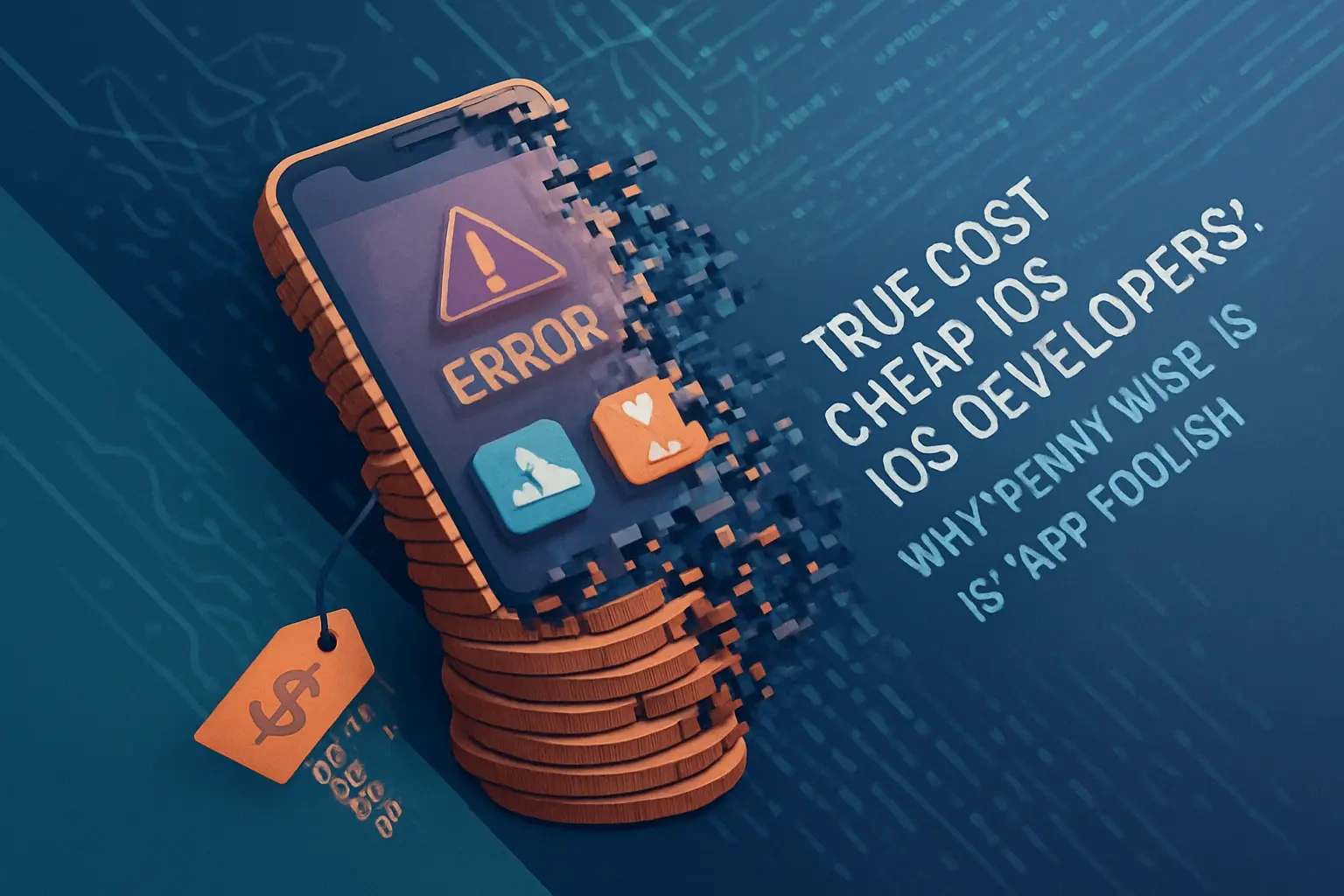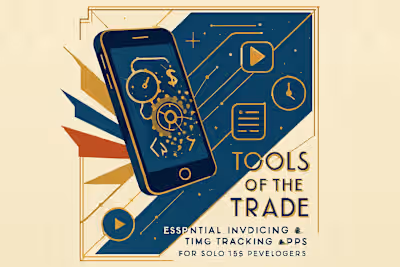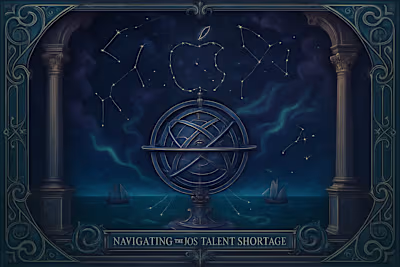The True Cost of Cheap iOS Developers: Why 'Penny Wise' is 'App Foolish'

The True Cost of Cheap iOS Developers: Why 'Penny Wise' is 'App Foolish'
The Lure of the Low-Cost Developer
The Initial Appeal of Saving Money
The Relationship Between Price and Quality
The Hidden Costs of Poor-Quality Code
What is Technical Debt?
Compromised Quality and Performance
Lack of Scalability
How a Bad Hire Impacts Your Business
Damaged Brand Reputation
Lost Productivity and Revenue
The High Cost of Replacement
Making the Smart Investment
References
The True Cost of Cheap iOS Developers: Why 'Penny Wise' is 'App Foolish'
In the race to build an app, the temptation to cut corners by hiring a cheap developer is strong. However, this seemingly savvy financial move often leads to higher costs in the long run due to technical debt, poor quality, and a damaged reputation. Understanding the competitive iOS talent market is the first step to appreciating why quality comes at a price. This article explores the hidden dangers of budget development and why investing in experienced iOS developers from the start is the most cost-effective strategy.
We've all been there. You have a brilliant app idea, but your budget feels tighter than a new pair of shoes. The dangers of a quick hire might not seem obvious when you're staring at quotes that vary by thousands of dollars. But here's the thing: choosing the cheapest option today could cost you ten times more tomorrow.
Think of it like buying a car. Sure, you could grab that rusty beater for $500. It'll get you from point A to point B... until the transmission falls out on the highway. Suddenly, that "bargain" becomes a money pit. The same principle applies to iOS development, except the stakes are often much higher.
The Lure of the Low-Cost Developer
Let's be honest. When you see one developer quoting $5,000 and another asking for $50,000, your wallet starts screaming. The lower price tag looks incredibly attractive, especially if you're bootstrapping a startup or working within tight corporate constraints.
The Initial Appeal of Saving Money
Business owners often choose low prices over quality when outsourcing app development, hoping to launch quickly and cheaply. It makes sense on paper. Why pay premium prices when someone else promises the same result for a fraction of the cost?
This approach typically stems from a minimalistic quote that fails to account for the project's true complexity. That bargain developer might promise you the moon, but they're often working with outdated tools, limited experience, or unrealistic timelines. They'll tell you what you want to hear because they need the work.
I've seen countless entrepreneurs fall into this trap. They receive a quote that seems too good to be true (spoiler alert: it usually is). The developer promises a fully functional app in two months for the price of a used laptop. Six months later, they're still waiting for a working prototype.
The real kicker? These low-ball quotes rarely include essential features. Want push notifications? That's extra. Need user authentication? Add another zero. By the time you've added everything your app actually needs, you're approaching the original "expensive" quote anyway.
The Relationship Between Price and Quality
In app development, there's a well-established link between price and quality. This isn't snobbery or elitism – it's simple economics. Experienced developers charge more because they bring more to the table.
Lower-priced developers may lack the incentive or expertise to invest the necessary time and effort. They're often juggling multiple projects to make ends meet. Your app becomes just another task to rush through, not a product to perfect.
Think about it from their perspective. If they're charging rock-bottom prices, they need volume to survive. That means cutting corners, using generic solutions, and moving on to the next project as quickly as possible. Quality becomes a luxury they can't afford.
Meanwhile, experienced developers understand that their reputation depends on delivering excellence. They've spent years honing their craft, learning best practices, and understanding what makes apps successful. They charge accordingly because they know their work will save you money in the long run.
The Hidden Costs of Poor-Quality Code
Cheap app development often comes with hidden costs that surface long after the initial build. These costs manifest as poor performance, security vulnerabilities, and a mountain of technical debt that can bury your project.
What is Technical Debt?
Technical debt is the implied cost of rework caused by choosing an easy, limited solution now instead of using a better approach that would take longer. It's like using duct tape to fix a leaky pipe. Sure, it stops the water today, but eventually, you'll need to tear out the wall and replace everything.
Here's a sobering statistic: organizations can waste 23-42% of their development time dealing with technical debt. That's nearly half your resources going toward fixing past mistakes instead of building new features.
Technical debt accumulates in sneaky ways. Maybe your cheap developer hardcoded values instead of making them configurable. Perhaps they skipped writing tests to save time. Or they might have used outdated libraries that now have security vulnerabilities.
Each shortcut seems minor at the time. But they compound like credit card interest. Before you know it, simple changes take weeks instead of hours. Adding new features becomes a nightmare because the codebase is held together with digital duct tape and prayers.
Compromised Quality and Performance
Developers on a tight budget often use generic templates and unoptimized code, leading to slow load times, laggy interfaces, and frequent crashes. This poor performance frustrates users and damages the app's usability.
Picture this: A user downloads your app, excited to try it out. They tap the icon and wait. And wait. After 10 seconds (an eternity in app time), it finally loads. They try to navigate, but every action has a delay. Buttons don't respond immediately. Screens stutter during transitions.
How long before they delete your app? Studies show you have about 3 seconds before users start abandoning ship. Poor performance isn't just annoying – it's a business killer.
Cheap developers often copy-paste code from various sources without understanding how it all fits together. They might use resource-heavy animations that look cool but drain battery life. Or they'll implement features in the most straightforward way possible, ignoring efficiency entirely.
The result? An app that technically works but provides such a poor experience that users flee to your competitors. All that money you "saved" on development just cost you your entire user base.
Lack of Scalability
An app built without a scalable architecture will struggle as the user base grows. A system that works for 100 users might crash under the load of 10,000, leading to severe performance degradation and missed growth opportunities.
Imagine launching your app and getting featured on the App Store. Suddenly, thousands of users flood in. This should be your moment of triumph. Instead, your servers crash, the app becomes unresponsive, and those excited new users leave one-star reviews.
Cheap developers rarely think about scalability. They build for the immediate need, not future growth. They might store all data locally on the device, making syncing impossible. Or they'll use a database structure that works fine for small datasets but grinds to a halt with real-world usage.
Fixing scalability issues after launch is like trying to change a car's engine while driving. It's expensive, risky, and often requires rebuilding large portions of the app. What could have been addressed during initial development for a few thousand dollars now costs tens of thousands – plus lost revenue from downtime.
How a Bad Hire Impacts Your Business
A single bad hire can have devastating effects that ripple through the entire organization, from lost productivity to a decline in team morale. When that bad hire is responsible for your iOS app, the damage multiplies exponentially.
Damaged Brand Reputation
A faulty or unusable app is a direct reflection of your brand. In today's connected world, bad news travels at the speed of light. One frustrated user can spark a social media firestorm that takes years to recover from.
Negative reviews and a poor user experience lead to users deleting the app or not downloading it at all. Once your app rating drops below 3 stars, you're essentially invisible in the App Store. New users won't even give you a chance.
Consider how you choose apps yourself. Do you download the one with 2.5 stars and reviews complaining about crashes? Of course not. You go with the 4.5-star option that users rave about. Your potential customers think the same way.
Brand damage extends beyond the app itself. Users don't think, "Oh, they just hired a bad developer." They think, "This company doesn't care about quality." That perception bleeds into everything else you do. Your website, your customer service, your products – everything becomes suspect.
Recovery takes time and money. You'll need to rebuild the app properly, implement aggressive marketing to overcome negative perceptions, and possibly rebrand entirely. All because you wanted to save a few thousand dollars upfront.
Lost Productivity and Revenue
A bad hire slows the entire team down, as others have to pick up the slack or fix their mistakes. If you have in-house developers, they'll spend their time deciphering poorly written code instead of building new features.
This productivity drain is insidious. Your team might spend hours in meetings trying to understand why certain decisions were made. They'll waste days tracking down bugs that proper coding practices would have prevented. Every task takes longer because they're working around the mess left behind.
Delayed product launches and missed deadlines directly hit your revenue. While competitors release new features and capture market share, you're stuck in cleanup mode. That first-mover advantage you hoped to gain? Gone, along with the customers who found alternatives.
The opportunity cost is staggering. Instead of innovating and growing, you're treading water. Your development roadmap gets pushed back months or even years. Features that could have driven revenue remain unbuilt because all resources go toward fixing fundamental problems.
The High Cost of Replacement
The cost of a bad hire can be up to 30% of the employee's first-year earnings. For contractors and freelancers, the math gets even worse. You've paid for work that needs to be completely redone.
But the financial cost is just the beginning. Consider the time and resources spent on recruiting, onboarding, and training, only to start the process all over again. Each hiring cycle takes weeks or months. That's time your app isn't improving, your users aren't being served, and your competitors are pulling ahead.
There's also the knowledge transfer problem. The cheap developer probably didn't document their code properly. They might have used unusual patterns or made architectural decisions that only make sense to them. Your new developer needs to reverse-engineer everything before making progress.
Team morale suffers too. Good developers hate working with bad code. They might start looking for other opportunities rather than deal with the mess. Now you're not just replacing one developer – you risk losing your entire team.
Making the Smart Investment
The evidence is clear: hiring cheap iOS developers is a false economy. What looks like savings today becomes tomorrow's financial nightmare. But this doesn't mean you need to hire the most expensive developer you can find.
Smart hiring means finding developers who provide value. Look for those who understand your business goals, not just technical requirements. They should ask questions about your users, your growth plans, and your long-term vision.
Check their portfolio carefully. Don't just look at the apps they've built – download them. Use them. Read the reviews. A developer with a track record of successful, well-reviewed apps is worth their weight in gold.
Consider the total cost of ownership, not just the initial quote. A more expensive developer who builds a scalable, maintainable app saves money over time. They'll help you avoid the technical debt trap and position your app for growth.
Remember, your iOS app isn't just code ��– it's your business's digital face. It's how thousands or millions of users will interact with your brand. Investing in quality development isn't an expense; it's the foundation of your mobile strategy.
The choice is yours. You can go cheap now and pay dearly later. Or you can invest wisely from the start and build something that truly serves your users and your business. In the world of iOS development, penny wise truly is app foolish.
References
Like this project
Posted Jul 6, 2025
Tempted to hire a cheap iOS developer? Discover the hidden costs of low-quality code, from buggy apps to complete project failures. Learn why investing in quality talent saves you money.










